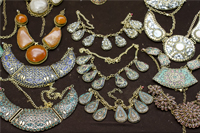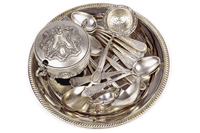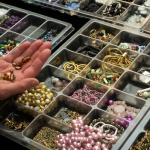
BlogArticle Object
(
[_table:protected] => blog_tags a JOIN blog_articles_tags b ON a.id = b.tag_id JOIN blog_articles c ON b.article_id = c.id
[validations:protected] => Array
(
[title] => Array
(
[required] => Please provide a title.
)
[content] => Array
(
[required] => Please enter the article contents.
)
[date_published] => Array
(
[date] => A valid date is required.
)
)
[_db:protected] => NiftyEngine\Database Object
(
)
[_validator:protected] =>
[_loaded:protected] =>
[_guarded:protected] => Array
(
)
[_allowed:protected] => Array
(
)
[_query:protected] => Array
(
[primary] => id
[fields] => c.*
[where] => WHERE a.slug = 'jewelry-care'
[order] => ORDER BY c.date_published desc
[limit] => LIMIT 0, 6
[page] => 1
)
[_changed:NiftyEngine\Model:private] => Array
(
)
[_limit] => 6
[_offset] => 0
[id] => 0
[total_count] => 6
[page] => 1
[page_count] => 1
[_cache] => NiftyEngine\Cache Object
(
[key:protected] =>
)
[records] => Array
(
[0] => BlogArticle Object
(
[_table:protected] => blog_articles
[validations:protected] => Array
(
[title] => Array
(
[required] => Please provide a title.
)
[content] => Array
(
[required] => Please enter the article contents.
)
[date_published] => Array
(
[date] => A valid date is required.
)
)
[_db:protected] =>
[_validator:protected] =>
[_loaded:protected] =>
[_guarded:protected] => Array
(
)
[_allowed:protected] => Array
(
)
[_query:protected] => Array
(
[primary] => id
[fields] => *
)
[_changed:NiftyEngine\Model:private] => Array
(
)
[id] => 3884
[title] => What You Should Know About Georgian Jewelry
[slug] => what-you-should-know-about-georgian-jewelry
[content] => Antique jewelry lovers might already know a thing or two about this particular period in American history where certain distinctive types of jewelry were in vogue. But whether you’re an avid vintage fashion lover or just starting to read up about antique jewelry, there could be something new to learn about this particular type of jewelry, specifically Georgian jewelry.
The Georgian Period
The period between 1714 and 1837 is known as the Georgian period because of events happening in Great Britain: namely, the rule of kings George I, II, III and IV during this time. It was a time of tumultuous change and rapid growth. There were several wars that took place, most notably the Seven Years War between 1756 and 1763.
The Treaty of Paris ended the revolutionary war in the United States, and was when Britain acknowledged America as an independent, sovereign nation. Soon after, the first U.S President, George Washington, was elected in 1789. This was also the period of the Industrial Revolution which was driven by massive advancements in manufacturing processes, and which spurred national growth and wealth.
Georgian Jewelry
During this period, the wealthy were known to wear fine jewelry. This Georgian jewelry was of exquisite handcrafted quality and highly prized possession at the time, and even now. These pieces were typically very ornate, with intricate, hand cut designs. Diamonds were very popular at the time, and the choicest cuts were the rose cut and the old mine. In the mid-1700s however, colored gemstones such as rubies, emeralds and sapphires became more prevalent. Metals often used in crafting this jewelry included silver for gemstone settings, 18 karat or higher yellow gold, steel, iron, and a substitute gold material called pinchbeck.
Cameos
One of the popular types of jewelry were called cameos. Cameos are antique carved pieces showing subjects like Greek gods and goddesses, are usually in an oval shape, and can be made into brooches, worn as pendants, or even placed in tiaras. Emperor Napoleon’s wife Josephine is credited for starting an international fashion trend of cameos with her variety of accessories, including her most elaborate gold tiara set with pearls and large cameos telling the story of Cupid and Psyche.
Cut Steel Jewelry
This interesting idea for jewelry came about initially in France in 1759, when they were worn as a substitute for the confiscated jewelry during King Louis XV’s campaign to fund the Seven Years War. Cut steel jewelry, made from tiny faceted and polished steel studs, were crafted to look like gemstones and fixed onto a backing plate. The earliest cut steel pieces were made from recycled steel nails; however, as demand grew the designs became increasingly more intricate, and sometimes were set with pearls and jet.
The Value Of Antiques
If you believe you own a piece of jewelry dating back to the Georgian period, there is a high chance that it might fetch a decent sell value for you. Unless you definitely wish to keep the item as a family heirloom, it would be interesting for you to get a valuation to see what your jewelry is worth. Global Gold and Silver is always happy to speak with you, so don’t hesitate to get in touch!
[author_id] => 0
[date_published] => 2018-09-06 05:20:00
[date_added] => 2018-09-06 12:59:49
[date_updated] => 2018-11-02 14:04:35
[status] => pub
[tag] => Array
(
[0] => Jewelry Care
)
[comments] => Array
(
)
)
[1] => BlogArticle Object
(
[_table:protected] => blog_articles
[validations:protected] => Array
(
[title] => Array
(
[required] => Please provide a title.
)
[content] => Array
(
[required] => Please enter the article contents.
)
[date_published] => Array
(
[date] => A valid date is required.
)
)
[_db:protected] =>
[_validator:protected] =>
[_loaded:protected] =>
[_guarded:protected] => Array
(
)
[_allowed:protected] => Array
(
)
[_query:protected] => Array
(
[primary] => id
[fields] => *
)
[_changed:NiftyEngine\Model:private] => Array
(
)
[id] => 3881
[title] => How Precious Is The Silverware In Your Home?
[slug] => how-precious-is-the-silverware-in-your-home
[content] => Many of us have legacy dinner plates or other flatware handed down to us by our grandmothers or grandfathers. Sometimes it’s just one or two pieces of silver crockery, and other times it could be an entire set of dining silver, complete with utensils. But does this inheritance hold value for you over and above its nostalgic worth? Could it also have a monetary value? It depends on several factors, including the age of the silverware, and how it was made.
A Brief History Of Silverware
In the 12th century, silverware first became popular in England among the noble families. As they were made from the same quality of silver that was used in coins at the time, that is pure silver, they were understandably very expensive and could only be afforded by royalty.
The Industrial Revolution brought about a change in the prestige of silverware. For the first time, silverware could be mass produced, and hence began to lose much of its luxury status. At the same time, more families being able to possess silverware actually also increased their own status, resulting in a much larger middle class. From the mid 19th century, silverware became a common way for families to display their wealth, as well as their status and improved standards of living.
Then came the Great Depression. The broad category of middle class found it difficult to maintain their luxurious lifestyles, with numerous varied types of silverware which mostly served only one function like butter spreaders, bouillon spoons and pastry forks. In addition, labor costs skyrocketed and it was becoming less viable for families to afford the number of workers needed to care for all the silver. This brought about the advent of silver-plating as opposed to sterling silver pieces. Silverware designs also became much simpler as ornate designs required hand polishing to maintain their look.
A Rough Idea Of Silverware Value
Silverware from the 12th century is the most valuable, and not only for its meltdown value due to its silver composition (usually sterling silver or pure silver). If the silverware has been well-maintained and is in good and original condition, it would actually be highly valued above its intrinsic value by museums and collectors for its historic and antique properties.
For mass-produced pieces of silverware, they would still have a high scrap value due to a high silver composition, or even gold composition if they had been heavily gilded. These tend to also be beautifully made and ornate, and could fetch a good price in the resale market if still in good condition. However, silver-plated flatware would likely have greater emotional value to your family as an heirloom, rather than a significant meltdown value or collectors’ value.
Get A Proper Valuation
To find out for certain what the potential meltdown or collector’s value of your silverware truly is, approach a reputable jewelry buyer such as Global Gold and Silver. We purchase silverware sets with historical value and can offer you a handsome price for it. Speak to us today!
[author_id] => 0
[date_published] => 2018-09-06 04:20:00
[date_added] => 2018-09-06 12:32:08
[date_updated] => 2018-11-05 12:24:28
[status] => pub
[tag] => Array
(
[0] => Jewelry Care
)
[comments] => Array
(
)
)
[2] => BlogArticle Object
(
[_table:protected] => blog_articles
[validations:protected] => Array
(
[title] => Array
(
[required] => Please provide a title.
)
[content] => Array
(
[required] => Please enter the article contents.
)
[date_published] => Array
(
[date] => A valid date is required.
)
)
[_db:protected] =>
[_validator:protected] =>
[_loaded:protected] =>
[_guarded:protected] => Array
(
)
[_allowed:protected] => Array
(
)
[_query:protected] => Array
(
[primary] => id
[fields] => *
)
[_changed:NiftyEngine\Model:private] => Array
(
)
[id] => 3880
[title] => 5 Methods To Verify If You Have Real Gold
[slug] => 5-methods-to-verify-if-you-have-real-gold
[content] => Gold is considered a long-lasting metal, as it doesn’t tarnish or rust, and is dissolved only by nitro-hydrochloric acid. Gold also conducts heat and electricity, is non-magnetic and is malleable. Knowing these properties of gold can actually help you do a quick check to find out if you have real gold that could be worth something to a gold buyer.
The Magnet Test
It is better to test this with a strong magnet to be sure of the accuracy of the test. As gold is non-magnetic, it would not be attracted by the magnet. If it is attracted, it is likely a gold alloy, gold plated, or a fake. When trying out this test, do remember that jewelry pieces usually have certain elements such as clasps or wires which are not made from gold and could be attracted to the magnet. Also, do note that if the piece is not magnetic, it could also be made from other precious metals such as silver, so it’s best to do further testing on your item to verify that it is real gold.
The Float Test
For this test, you should prepare a container filled with enough water that your gold item can be fully submerged in, so as to increase the accuracy of the test. Gold has a high density of 19.32 grams per ml, so if you place it in a cup or bowl of water, it would definitely sink. If it half floats it would likely be a gold alloy, and fake or gold plated items would hover or float. Do note however in doing this test that a fake item could be made of other heavy metals which also sink, so if your item sank but you still are unsure, try another test.
The Magnifying Glass Test
If you have a magnifying glass at home, grab it and look at your gold item through the lens. Carefully inspect it for any signs of discoloration, as this would indicate it is not gold or is gold plated. Also check the color and shininess, as pure gold is not very shiny, and in fact has a soft yellow color, instead of a reddish toned item which would likely be a fake.
The Hallmark Test
Check your item for markings, stamps or other hallmarks. These might be on the inside surface or near the clasp. Such markings show gold purity in karats and also may bear the maker’s stamp.
Gold Testing Machines
The most accurate of testing methods which can also provide specific information about your item’s gold purity. These are XRF thermo and electronic gold testing machines. However, these are specialized items which can be expensive or hard to come by.
A professional gold buyer would be able to give you a proper valuation of your gold, as well as further information such as any potential added value as a collector’s item and more. Global Gold and Silver has plenty of satisfied customers who have sold their gold and silver jewelry and other items with us. Contact us today!
[author_id] => 0
[date_published] => 2018-09-06 04:00:00
[date_added] => 2018-09-06 11:59:22
[date_updated] => 2018-11-05 12:25:01
[status] => pub
[tag] => Array
(
[0] => Jewelry Care
)
[comments] => Array
(
)
)
[3] => BlogArticle Object
(
[_table:protected] => blog_articles
[validations:protected] => Array
(
[title] => Array
(
[required] => Please provide a title.
)
[content] => Array
(
[required] => Please enter the article contents.
)
[date_published] => Array
(
[date] => A valid date is required.
)
)
[_db:protected] =>
[_validator:protected] =>
[_loaded:protected] =>
[_guarded:protected] => Array
(
)
[_allowed:protected] => Array
(
)
[_query:protected] => Array
(
[primary] => id
[fields] => *
)
[_changed:NiftyEngine\Model:private] => Array
(
)
[id] => 3862
[title] => Is your Silverware actually Sterling Silver?
[slug] => is-your-silverware-actually-sterling-silver
[content] => Many people think they have real Silverware but come to be disappointed when they find out that it was not real and only plated or pewter. There are many ways of identifying what your silver really is, let me help you with that with a simple few steps.
1.
Look for a mark on the silverware of 925, STERLING or 925/1000. The mark is usually found on the underside of the piece of flatware. One of these marks is a surefire way to tell if your flatware is made of sterling silver. Flatware could also be of lower purity such as 90% which would be marked 900, 80% which would be marked 800 or 835 and 70% which would be marked 700.
2.
Put a magnet on the silverware to see if it is attracted to it. A magnet will not be attracted to pure silver flatware, only steel and other metals. If the magnet is not attracted to the silverware, there is a good chance it is sterling silver.
3.
Wipe the silver with a silver polish cloth gently as if you were trying to clean it. If your silverware is made from any purity of silver you should see black tarnish rub off on the cloth. Pure silver is subject to oxidation just from being exposed to the air. Steel and other metals will not tarnish in this way.
4.
Look for a mark on the silverware such as a crown, crest or lion. Sterling silver from countries outside of the United States often has a mark as opposed to STERLING or 925. The marks can be small and hard to see, especially if the piece is worn. A maker’s mark is a fair indicator your piece is pure silver especially if your piece is not attracted to a magnet and black tarnish rubs off on a polishing cloth.
These are ways that you can educate yourself on knowing what to look for to be able to authenticate your items on your own, which can be quite easy. This is especially important if you're looking to sell sterling silverware
[author_id] => 0
[date_published] => 2013-12-04 17:10:00
[date_added] => 2013-12-04 17:08:41
[date_updated] => 2018-11-05 12:33:09
[status] => pub
[tag] => Array
(
[0] => Selling Silver
[1] => Jewelry Care
)
[comments] => Array
(
)
)
[4] => BlogArticle Object
(
[_table:protected] => blog_articles
[validations:protected] => Array
(
[title] => Array
(
[required] => Please provide a title.
)
[content] => Array
(
[required] => Please enter the article contents.
)
[date_published] => Array
(
[date] => A valid date is required.
)
)
[_db:protected] =>
[_validator:protected] =>
[_loaded:protected] =>
[_guarded:protected] => Array
(
)
[_allowed:protected] => Array
(
)
[_query:protected] => Array
(
[primary] => id
[fields] => *
)
[_changed:NiftyEngine\Model:private] => Array
(
)
[id] => 3550
[title] => Silver Jewelry Care
[slug] => silver-jewelry-care
[content] =>  Besides monetary value, don't hesitate to appreciate the design value of your piece; wear that pendant with pride! Nothing is more timeless than an understated yet opulent silver fashion statement. Keeping your jewelry clean will increase both the monetary and sentimental value of your prized silver jewelry pieces.
Besides monetary value, don't hesitate to appreciate the design value of your piece; wear that pendant with pride! Nothing is more timeless than an understated yet opulent silver fashion statement. Keeping your jewelry clean will increase both the monetary and sentimental value of your prized silver jewelry pieces.
You don't need to visit a professional to clean your silver jewelry. Simply take a bowl and line the inside with aluminum foil. After you set your jewelry in the bottom of the bowl pour just enough hot water to completely submerge the silver; the hotter the better! For the next step you'll need to add equal amounts of baking soda and salt. You only need to let the solution sit for 10 minutes at most. This is because the chemical reaction is converting the silver sulfide (tarnished coating) and aluminum into pure silver (6 Ag0) and aluminum sulfide. It may seem magical, but it's owed to the brialliance of science. If there are any leftover bits of grime, rest assured you can simply add more salt and baking soda until the job gets done!
If you're pleased with the end result of this brilliant D.I.Y restoration don't forget to give you're jewelry a good rinse in cool water and pat it dry with a towel. This is one of the best proven methods of caring for silver items. This ensures that you can maximize the true value of your silver or sterling silver jewelry. While you may get an impressive return from selling silver to your local silver buying professional, you can also get a great deal at your local gold or silver jewelry trading party. You can check meetup.com to find these fun little gatherings. They are quite commonplace in Manhattan, Brooklyn and the greater tri-state area.
While these are methods may be foolproof ways to clean silver, they certainly aren't foolproof against fools! Always be prudent and ensure that other precious metal, gem, or jewel embellishments won't be harmed by any of these cleaning treatments. For example, turquoise and amethyst can get permanently damaged by such treatments. Pearls are also vulnerable to damage from abrasive substances such as baking soda.
Always do your online research and consult a local jeweler for their professional advice.
[author_id] => 2
[date_published] => 2013-08-31 11:32:00
[date_added] => 2013-08-30 20:32:24
[date_updated] => 2018-11-05 12:38:08
[status] => pub
[tag] => Array
(
[0] => Jewelry Care
)
[comments] => Array
(
)
)
[5] => BlogArticle Object
(
[_table:protected] => blog_articles
[validations:protected] => Array
(
[title] => Array
(
[required] => Please provide a title.
)
[content] => Array
(
[required] => Please enter the article contents.
)
[date_published] => Array
(
[date] => A valid date is required.
)
)
[_db:protected] =>
[_validator:protected] =>
[_loaded:protected] =>
[_guarded:protected] => Array
(
)
[_allowed:protected] => Array
(
)
[_query:protected] => Array
(
[primary] => id
[fields] => *
)
[_changed:NiftyEngine\Model:private] => Array
(
)
[id] => 3017
[title] => Five Tips to Redesigning Jewelry
[slug] => five-tips-to-redesigning-jewelry
[content] =>  It can be hard to sell old jewelry, especially if it doesn’t fit into today’s fashion or even your own style. So why not redesign it? Redesigning a piece of old jewelry can make a big difference in the amount you receive for the piece. Here are a few tips to keep in mind when redesigning:
It can be hard to sell old jewelry, especially if it doesn’t fit into today’s fashion or even your own style. So why not redesign it? Redesigning a piece of old jewelry can make a big difference in the amount you receive for the piece. Here are a few tips to keep in mind when redesigning:
1. Keep an open mind.
You may have bracelets or rings that you don’t like to wear or were family heirlooms. The stones or charms on the jewelry could be used to make a necklace or earrings. Let your imagination run wild! You can give your jewelry a new life to someone who will appreciate it.
2. Do your research.
It’s good to research the style and fashion of today, as well as what your jewelry could be worth as is. If you feel your jewelry might receive more attention after a redesign, then figure out what piece of jewelry your stones could be more eye-catching as. Find out today’s value of what you plan on redesigning it as, you might be surprised if your jewelry is worth more as is.
3. Look for inspiration.
There are many places that you can find inspiration to create new and unique pieces. Play around with the jewelry. For rings try it on different bands, or try a bracelet as a necklace. You can often find inspiration looking through magazines or even going on a walk.
4. Get an opinion.
It always helps when you can get a second opinion on your new creation. Ask someone you trust to give an honest opinion and what you should change or not change.
5. Try it on.
There might be an easy explanation as to why a piece does or does not work in your style. Try wearing it after you’ve redesigned it and see how it feels. This is a true test to see if the piece works or what you need to fix. Even replacing a clasp can make a difference.
Using different beads or adding more stones to a piece can be enough to change your opinion of it. Make sure you look into the new value of your redesigned piece. Simple redesign changes can change the life of the jewelry.
[author_id] => 2
[date_published] => 2012-12-28 10:55:00
[date_added] => 2012-12-27 16:55:21
[date_updated] => 2018-11-06 07:35:11
[status] => pub
[tag] => Array
(
[0] => Jewelry Care
[1] => Jewelry Trends
)
[comments] => Array
(
)
)
)
)





Copyright © 2025 GLOBAL GOLD AND SILVER




